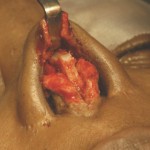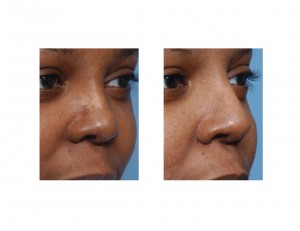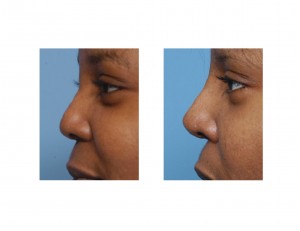Background: Rhinoplasty in the non-caucasian ethnic nose poses different challenges than many typical rhinoplasty procedures. The goal of making a more defined and less wide nose requires a major change in the cartilage construct of the nose. Increasing the height of the bridge and the tip requires a considerable push from beneath to lift often heavy and thick nasal skin. Such skin also limits how nasal definition can eventually be seen.
Such augmentation rhinoplasties usually encounter the classic debate of how to do it…synthetic implants vs rib cartilage grafts. There are advocates on both sides of that discussion and patients will often have a preference as well. Most of the time surgeons and patients will choose a synthetic implant because it is easier and has a much quicker recovery. While I am not a personal fan of synthetic materials in the nose, I do recognize why it is a frequent and appealing choice.
Despite a surgeon’s best efforts, synthetic implant augmentation rhinoplasties can and do fail. Failure may be defined as either an inadequate amount of aestheic projection or an infection or exposure of the implant. Once either occurs, the balance is now tipped towards an autologous cartilage graft approach which means a rib harvest must be considered.
Case Study: This 35 year-old African-American female had two prior rhinoplasties in effort to give her nose more definition and height. The first rhinoplasty used her septal cartilage and the second procedure used Gore-tex sheeting on top of her prior cartilage grafts. She remained unhappy due to the lack of any significant dorsal height increase and a persistently flat and broad nasal tip. She also had a bump along the right middle vault which I assumed was either cartilage or implant-related.



Case Highlights:
1) Significantly improving the nose shape of the African-American nose is often inadequate from septal cartilage only or small amounts of synthetic materials.
2) Revision rhinoplasty of a ‘failed’ primary augmentation procedure requires cartilage grafting, usually from the rib given the volume needed.
3) Increasing dorsal height and improved tip projection requires a dorso-columellar strut rib graft configuration.
Dr. Barry Eppley
Indianapolis, Indiana


